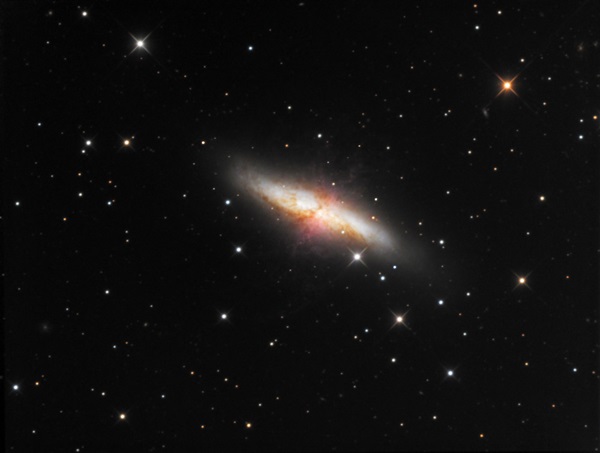Key Takeaways:
M82 — also known as the Cigar Galaxy — and neighboring M81 (see #92), together make up one of the night sky’s dynamic duos. M82 is one of the closest (12 million light-years) examples of an edge-on system in starburst chaos. In images, it appears like an extragalactic radical, with spiked “hairs” bristling off a cigar-shaped body tattooed with invisible dark matter.
German astronomer Johann Elert Bode discovered this “nebulous patch” on the same night as M81, noting its elongated form. In 1871, William Parsons, Earl of Rosse, noted curious dark bands crossing its length. Later astronomers suspected the galaxy was experiencing violent explosions — and they were right. We now know its central region is the site of intense starburst activity, with 40 or so supernovae in the early stages of expansion.
Starburst galaxies create stars at a rate tens or even hundreds of times faster than normal galaxies. A brush with M81 hundreds of millions of years ago triggered this stellar chaos, making the galaxy five times more luminous than our Milky Way. In red-sensitive images, long filaments stream out at right angles from the galaxy’s central region to about 34,000 light-years. Enormous galactic winds and gas outflows are transporting up to some 50,000 suns of gas and dust into intergalactic space.
Through the telescope, M82 is a stunning sight, like a ghostly starship, cracked and floating through an interstellar graveyard. Immediately noticeable is that its western half is distinctly brighter than the eastern half. Most impressive are the energetic-looking bursts of starlight running lengthwise through most of the galaxy. Does the core look angular to you? If so, it’s an illusion created by wedgelike lanes of dust.
Make sure to explore Astronomy’s full list of 101 cosmic objects you must see. New entries will be added each week throughout 2022.
To get the latest astronomical news and observing content delivered directly to your door, subscribe to Astronomy magazine today!










